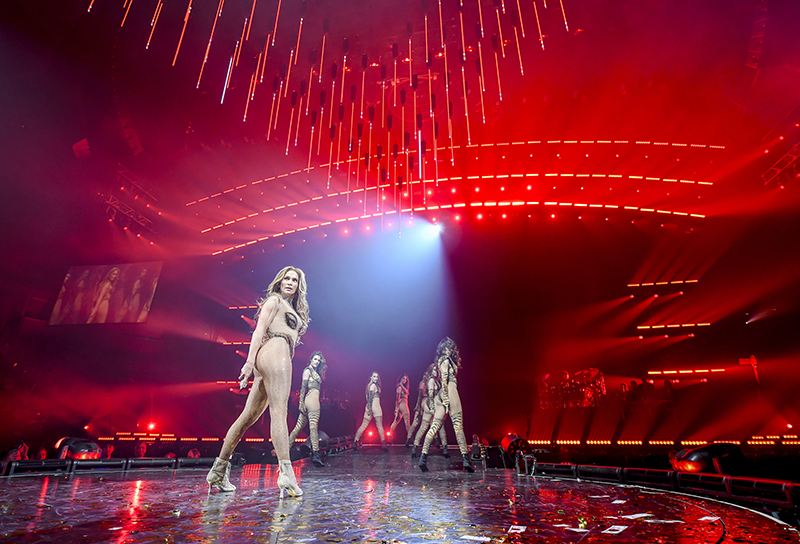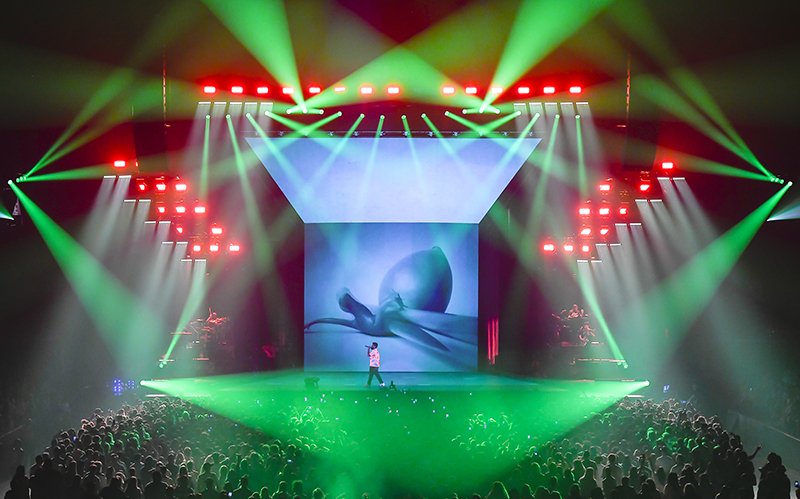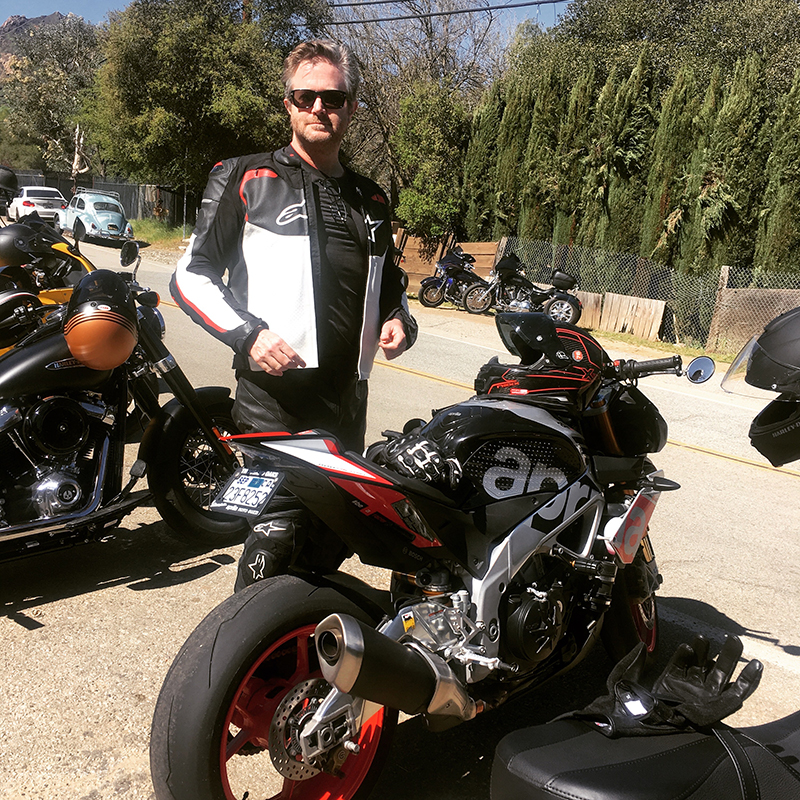
The Meandering and Evolutionary Path of a Lighting Designer
Born in London, Alex Reardon started in the production industry in lighting in 1993 and then moved to Los Angeles in 1998 as a lighting designer and programmer. Subsequently, he moved into set design, directing and creative producing for some of the best-known artists spanning a broad spectrum of musical styles. As a classically trained musician and the son of an architect, Alex’s design vision combines musicality with an appreciation of form and function. With such an auspicious background, his claim that he “bumbled” into his career led PLSN to his doorstep, to find out just how in fact he did it.
Early Beginnings
By age 10 or so, his school discovered through a musical aptitude test that he had an ear. His mother, “being the genius she is,” smiles Reardon, decided that, to get a scholarship to “one of those Hogwarts-style schools,” he should be put to work on an instrument most likely to be needed by the schools. Small in stature as a child, he was placed behind a viola.
This entree led to further explorations into the world of music. At the first concert he went to, Booker T and the MG’s. Alex recalls, “house lights went out, the band came on, the first lighting cue hit, and it was an instantaneous transition. I just had this sense of ‘Oh; this is where I should be.’”
Upon receiving a music scholarship, Reardon attended Radley College from 1979 to 1984, where he became far more interested in playing guitar, bass, piano and drums in various bands and going to live concerts. It was at Radley that Alex would meet and become friends with Nick Archdale, one the three founding partners of Flying Pig Systems (FPS). Though no one knew it at the time, the emergence of the FPS Wholehog product line would be central to the lighting control revolution in the 1990’s.
Knockin’ Around
An admitted “near Olympian Daydreamer” who was not sure just what he wanted to do with his life, Reardon’s next stops were far afield of what would become his future passion. “I’d like to say that I was a fully focused young man, burning with drive and attention, but the reality was that I was pretty hopeless.”
What to do while figuring out what you want to do? See the world! Explore! He and a couple random acquaintances embarked into Africa on a nine-month hitchhiking lark from Cape Town to Mombasa, Kenya. The extraordinary trip proved full of wonders and excitement as they ventured through game preserves and great physical landmarks like Victoria Falls until he wound up spending a terrifying week in a Zambian Army jail… but you should ask him about that over a drink.
Miraculously surviving the experience, Reardon joined the British Army, once safely back in the U.K. “It was a terrible career decision, but they taught me to march in a straight line, how to iron a shirt and how to shoot pretty well. I enjoyed the training, but in the back of my mind, I knew I would make a terrible officer.” The Army agreed, and when he showed up at Sandhurst for selection, they said “goodbye” and pointed towards the door.
Once again back in London, he heard another old Radley friend, Charlie Fisher of Fisher Lighting, was looking for help on the weekend. “I just needed to work, you know,” says Reardon, “but I became intrigued with concert lighting when I started reading about all the massive, late ‘80’s rigs.” He met Peter Barnes, “an icon of British LD-dom” as Reardon puts it, who gave him his first break as a board op while he was lighting crew chief for a young boy-band called East 17. It was a massively under-crewed tour, Reardon remembers fondly “where we didn’t get any sleep and did everything. It really was a trial by fire. No excuses, you gotta get it done, but each night we climbed into bunks on our tour bus with the thought, ‘It hurt like hell, but we did it.’”
From there, he started freelancing at places like Essential Lighting, The Spot Co and Meteorlites, but it was the invention of Wholehog that really broadened his opportunities. “Until Nick, along with Tom Thorne and Nils Thorjussen brought that marvelous creation to the world I’d been using dimmer desks to control [Clay Paky] Golden Scans, or the last analog out on a Celco Gold to control the binary access on a [High End Systems] Intellabeam controller. (Go on, kids — look it up…) I think the venerable Nook Schoenfeld and I were in the first 10 or so people to use the Hog, and for those reading this who never worked in the biz before it came out, I can’t tell you how revolutionary it was. There had been nothing like it, and pretty much everything we do today is related to what came out of that attic in Ealing.”
The two have been friends far longer than their 30 years in the business, though they did not realize it on their first meeting, which occurred anonymously in a Guatemalan jail around 1976. Both were under assumed identities and had been falsely accused on disparate charges as dense as the jungles they were pulled from. Records of the incidents are supposedly sealed (read: lost). “Who would have guessed then that we would both follow the same career path after that excursion, but years later we met up again over a console. Nook is known and loved by everyone,” says Reardon.

Welcome to America
A U.S. tour with Adam and the Ants in 1996 led to an introduction to Nick Jackson, founder of Light and Sound Design (LSD). Already proficient on the Icon desk from his work with the U.K. shop, Alex proposed bringing that skill set along with his Hog programming capabilities and client base to Jackson in exchange for navigating a work visa. “All right,” Nick replied. “Two years later, I’m flying into LAX, knowing only two people in the U.S. and wondering, ‘WTF have I done?’” A look at his brilliantly original body of work over the past 22 years, however, documents the answer to that question quite well. In 2018, he became a design partner with Silent House, a full-service production company providing production and design for television and live entertainment including creative direction, choreography and logistical solutions.
At a celebratory dinner party with friends, few of whom actually worked in the live event field, one asked him what it was like to work at Silent House. In an effort to express it in layman’s terms, Guy Phillips, a producer for the BBC, and the only other member of the party in the live event business, responded that it is a bit “‘like being called up to play for the Yankees,’” Reardon recalls. “I thought that was very flattering and generous of him.”
Silent House, created by Baz Halpin, “is a wonderful labyrinth of very creative, interesting people at the top of their game who also are very nice,” Reardon says. “It is a really great vibe because we all love the process of collaboration.” Tamlyn Wright and Cory FitzGerald are the other two design partners. Nolan Padilla, Melissa Garcia and a “bullpen” of extraordinarily talented Cinema 4D, Vectorworks and Photoshop masters enhance the team. Within the building complex known as The Flower Street Factory, where Silent House is located, are several associated partner businesses. Blink TV are content producers, as are Silent Partners, who also do content. Early Bird Visual Effects handles previz and all drafting duties. The wardrobe company Kismet, a dance studio and a film studio operate at “The Factory” as well. “It’s a wonderful resource,” says Reardon “I can just wander downstairs and bat around ideas of, ‘Hey, would it be possible to….’”

Influences, Perceptions, Challenges and Joys
Reardon finds himself influenced these days more by art and architecture than from other shows, though he can’t point to any one particular person as a technical or business teacher. “I would say that, in the comportment department, working on a few shows alongside Patrick Woodroffe was to observe a master-class in bringing calm to the proceedings. Trying to take the stress and angst out of the day, I think, is a very important part of what I do.”
The one moment on every show that he will never tire of is when house lights go out and the audience loses their “collective minds.” Years ago, Marc Brickman, another large influence (and hero) told Reardon he always tries to light a show for the worst seat in the house. “I have always been aware of the people that have saved up, got a ticket, driven to the gig, paid a fortune for a beer and parking and are so excited to be there.”
One of Reardon’s basic design philosophies centers on understanding the ratio between illumination and effects. For instance, opera necessitates illumination, while a DJ demands effects. Applying that ratio while applying restraint, he believes, is key to emotional visuals. “The effects engine, which the Hog One brought to the world, is a wonderful thing. To try and program some of the things we do without it would be horrific. But at the same time, not every song has to have all the light waving around like on a Telemundo game show.
“‘Why’ is a really important question,” continues Reardon. “Just because the guy who programmed it said you can is not reason alone to proceed. I’m not really critiquing other peoples’ work. I don’t think any of us should critique other peoples work because you never know what other forces came to bear.”
As one of the pioneering programmers in the intelligent lighting world, Reardon has a remarkably wide view of the abilities of others who have come up in the years after him. “I’m fortunate enough these days to be able to bring very good programmers in like Dan Norman, Joe Cabrera and Bobby Grey. I no longer have to think about my own personal knowledge of the console. Whereas with a really good programmer I can explain the idea behind the cue, or series of cues, and they can show me options.”
He considers the “head” he designed for Avicii back in 2012 as a landmark that he is very proud of. Totally unprecedented at the time, Reardon shares that “it took everything from people whose brains are far bigger than mine (Seth Robinson’s, for example) to make the creation a reality.”
He also recalls quite fondly lighting Tears For Fears 25 (or so) years ago, and is thrilled to design for them again for their multi-date, sold-out arena tour. “Their music is truly wonderful to light, and they are the greatest people to work with. Roland [Orzabal] didn’t remember my name, but he did remember my star sign, which is nice,” he beams.
“I think when I was on some of my earliest tours; I found the camaraderie amongst others who were ‘square pegs,’ something I really valued. I love that almost everyone in the biz is a little bit bonkers. Granted, when I started (has it been 30 years already?) there was a lot more ‘bonkers’ going on. Now that touring has become the primary income for many artists, I’m rather glad that the chaos and wildness has calmed down — we’d never get anything done otherwise!”
He is truly impressed with the next batch of artists coming out. “I’ve had the fortune to work with Troye Sivan, Brockhampton and Tyler the Creator, to name a few. They are on it — focused, nice, professional, curious and great to collaborate with. They all want something interesting, new, and ground-breaking and I think we are really pushing the industry along with these new acts.”

Live Music Becomes Big Business
Reardon has been represented by Rooftop Agency for the last five years. “Mike, Todd and Sydney are very good at negotiating the increasing complex deals that have to be done with an artist’s management. When I started, it was a handshake and cheers over a pint. Contracts have gone so far beyond the boilerplate stage, and often the lawyers writing these contracts are not necessarily familiar with the business. Their minutiae can be maddening, but not intended as a trap or way to trip a project up. So it is good to have representation on our side that does know and can suggest rewording in a contract that is less ambiguous or leaves loopholes for misinterpretation.”
The situation was much different in his early years. “In England, when I started, it was considered the height of hubris for a lighting designer to have an agent. But it is absolutely necessary now. As we have transferred the entire industry from being a marketing exercise for album sales to huge revenue generating enterprises, lawyers caught the scent. Ignoring it, pretending it’s all going to be fine; you will probably suffer.”

A Few More Thoughts
“In this strange, career-ladder free business we work, I’ve been able to find my own rungs by living the advice I give young kids who ask me how to get up the food chain; I think it really is a matter of just carrying on, do your best work and just be kind, and nice. It will help your career; it will help your soul. Being a nasty person is too caustic to yourself and others. The best way to talk a person off the ceiling is to listen to them off the ceiling. It’s a hard enough business to get by in. Make the world nicer. And if you f*ck up, admit it.”
For more information on Silent House, go to www.silent-house.com.


